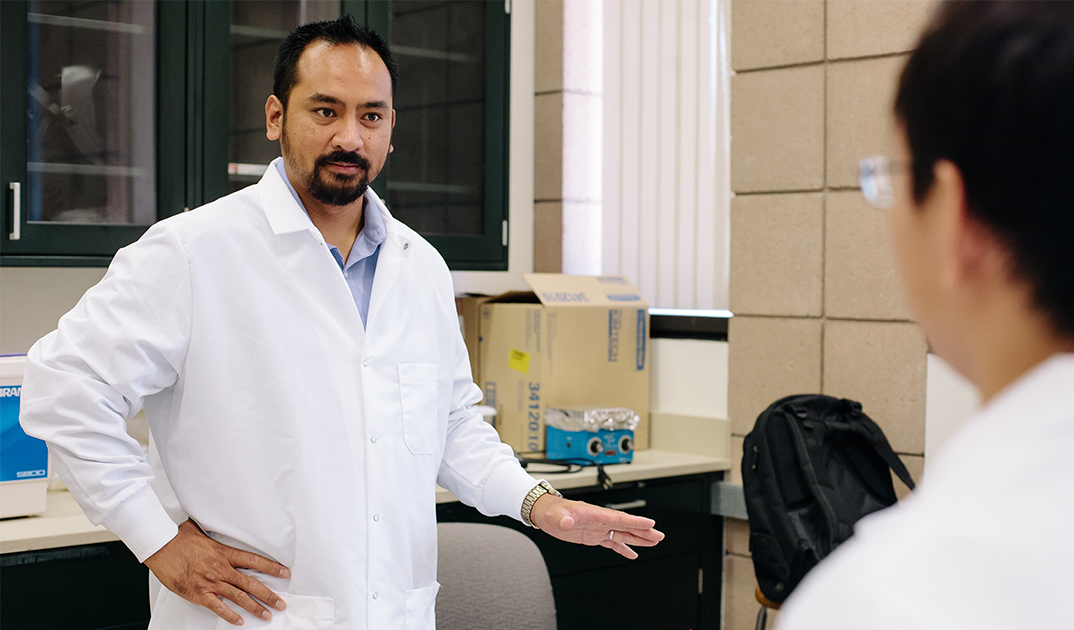Dato Lab Produces Novel Water-Repellent Graphene
May 9, 2022
An unexpected discovery by engineering professor Albert Dato and students in his Energy and Nanomaterials Lab holds exciting potential for creating robust water-repellent coatings using gas-phase-synthesized graphene (GSG) and other nanomaterials. The research by Dato, Weston Miller ’21 and Makenna Parkinson ’23 was published in ACS Materials Letters and Chemical & Engineering News.
Last summer, Miller and Parkinson were working on two projects: A National Science Foundation-funded project characterizing nanocomposites and a project supported by the College’s Rasmussen Summer Research fund that involved using graphene to separate oil from water. “While working on these projects, the students discovered that water droplets falling on our graphene powder were easily sliding off and bouncing from it,” says Dato. “This was a completely unexpected result since we weren’t even looking into this phenomenon called superhydrophobicity.”
The trio found the result so surprising that they decided to use the Rasmussen funds to purchase an instrument to measure the contact angle of water on materials. “Weston and Makenna measured the contact angles of spherical water droplets on both lotus leaves and our graphene and found that they were nearly identical,” Dato says. “Further experiments showed that water droplets rolled off the lotus leaves and our graphene at very low angles, which is called the Lotus Effect. At the time, we had absolutely no expertise in water repellent materials, so the three of us decided to take a deep dive into the literature and found out that achieving the water repellency of lotus leaves using artificial materials is a challenge that requires considerable resources and time. The students and I learned that graphene created by methods other than ours could only achieve what we were observing in the lab if the materials were significantly modified.”
Miller and Parkinson discovered that the graphene produced in the Dato Lab can repel water immediately after it is created. Graphene that is grown by other methods cannot achieve such water repellency without considerable chemical modification, and graphene that is made from exfoliating graphite also needs to be treated with chemicals to be able to repel water. “Our method of making graphene is sustainable and produces useful byproducts that can be collected and utilized in other applications,” says Dato. “In contrast, creating graphene by other methods requires significant energy and resources, and chemical modification can produce hazardous waste that is harmful to the environment.”
They decided to continue their research during the academic year, focusing on investigating what would happen if they coated other materials—metals, silicon, Scotch tape—with their graphene. “Although we discovered something novel in the summer, we wanted to see if we could take surfaces that were not water repellent and coat them with our graphene to make the surfaces non-wettable,” Dato says.
With the goal of testing the hypothesis that their graphene could protect surfaces from water droplets, Miller and Parkinson conducted experiments that showed exactly that: arbitrary wettable surfaces became non-wettable when covered with their graphene. “We decided to report our discovery to as wide of an audience as soon as possible,” Dato says.
“In the paper, we share some preliminary results of GSG on Scotch tape, but we want to test stronger adhesives to make more robust coatings, which is essential for actually using a material’s superhydrophobic properties in the real world,” says Parkinson. “One of the next things we’re focusing on is creating robust superhydrophobic coatings. We’re also looking at other carbon nanomaterials, since we now have established procedures and have the equipment necessary for contact angle measurements, roll-off angle measurements and droplet impact studies.”
That, Dato says, is exciting because highly water repellent surfaces are desired in numerous applications, “such as aircraft wings that resist icing in cold weather, ships that can resist corrosion and have low drag forces and even biomedical devices that can have tiny channels that can transport fluids with minimal effort. The graphene produced in our lab can potentially make these applications a reality.”
In addition to the discovery and resulting publication being remarkable, Parkinson and Dato are quick to point out that the discovery was a result of the unique research environment at HMC. “This is just another example of something special that happens at Harvey Mudd College. Students and faculty make impactful discoveries together,” says Dato, noting that the discovery also demonstrates how internal support like the Rasmussen Summer Research Fund enables faculty and students to make novel discoveries in the lab.
“I’m incredibly grateful to have had the opportunity to work in Prof. Dato’s lab,” says Parkinson. “I know that it is a unique privilege to be able to participate in this type of research while an undergraduate student, and I’m incredibly grateful to be at Mudd and to have this opportunity.”
